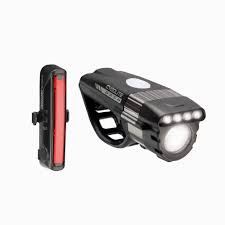The Best Bike Lights for Winter Cycling: See and Be Seen
.jpg) |
| Winter cycling can be a beautiful and exhilarating experience, but it comes with its own set of challenges.
One of the most significant is reduced visibility due to shorter days and inclement weather. Therefore, having the best bike lights is crucial for both seeing and being seen on the road. In this article, we will explore the essential features of bike lights for winter cycling, review some top-rated options, and provide tips on choosing the right lights for your needs. |
Why Winter Cycling Requires the Best Bike Lights
Reduced Daylight and Visibility
During winter, daylight hours are significantly shorter, meaning many cyclists find themselves riding in low-light conditions both in the morning and evening. Additionally, fog, rain, and snow can further reduce visibility. The best bike lights are designed to cut through these conditions, ensuring you can see the path ahead clearly and that other road users can see you. |
Safety Concerns
Safety is paramount for winter cyclists. Poor visibility increases the risk of accidents. The best bike lights best bike lights enhance your visibility, making it easier for drivers, pedestrians, and other cyclists to notice you. This is especially important at intersections and in heavy traffic areas. |
Key Features to Look for in the Best Bike Lights
Brightness (Lumens)
When selecting bike lights for winter cycling, brightness is a crucial factor. Measured in lumens, brightness determines how well you can see and be seen. For urban cycling, 200 to 500 lumens is typically sufficient. For rural or unlit paths, you might need 800 to 1200 lumens. |
Battery Life
Winter temperatures can drain batteries faster than usual. Opt for bike lights with long battery life and consider carrying spare batteries or a portable charger. USB rechargeable lights are convenient as you can charge them easily at home or work. |
Beam Pattern
A good beam pattern is essential for effective illumination. Look for lights with a wide beam for better peripheral visibility and a focused center beam to see further ahead. This combination ensures you are aware of your surroundings and any potential obstacles. |
Mounting Options
Secure and adjustable mounting options are vital for keeping your lights in place on bumpy winter roads. Many of the best bike lights come with versatile mounts that can be attached to various parts of your bike, such as handlebars, helmets, and seat posts. |
Top Recommendations for the Best Bike Lights for Winter Cycling
Front Lights
1. Cygolite Metro Pro 1100
The Cygolite Metro Pro 1100 is a powerful light offering 1100 lumens, making it ideal for both urban and rural settings. It features multiple lighting modes, including a steady pulse mode that helps increase visibility without blinding other road users. |
2. NiteRider Lumina 1200 Boost
The NiteRider Lumina 1200 Boost provides excellent brightness and long battery life. Its durable design withstands harsh weather conditions, and the easy-to-use mounting system ensures it stays in place on rough terrains. |
Rear Lights
1. Bontrager Flare RT
The Bontrager Flare RT is a compact and powerful rear light that offers visibility up to 2 kilometers away. It has multiple flash patterns and brightness settings, making it versatile for various riding conditions. |
2. Garmin Varia RTL515
The Garmin Varia RTL515 not only provides bright rear illumination but also includes radar technology that alerts you to vehicles approaching from behind. This added safety feature makes it one of the best bike lights for winter cycling. |
Tips for Maintaining Your Bike Lights
Regular Charging and Battery Care
Ensure your lights are fully charged before each ride. Cold weather can affect battery performance, so store lights at room temperature when not in use and charge them regularly. |
Clean and Inspect
Winter roads can be dirty and wet. Regularly clean your bike lights and inspect them for any damage. Keeping the lenses clean ensures optimal light output and visibility. |
Backup Plan
Always have a backup plan. Carry spare lights or batteries, especially for longer rides. Having a secondary light source can be a lifesaver if your primary light fails. |
Conclusion
Investing in the best bike lights is essential for safe winter cycling. Brightness, battery life, and durability are key features to consider when making your choice. By selecting the right lights and maintaining them properly, you can enjoy the beauty of winter cycling while staying safe and visible on the road. |
%20(1).jpg)

Comments
Post a Comment